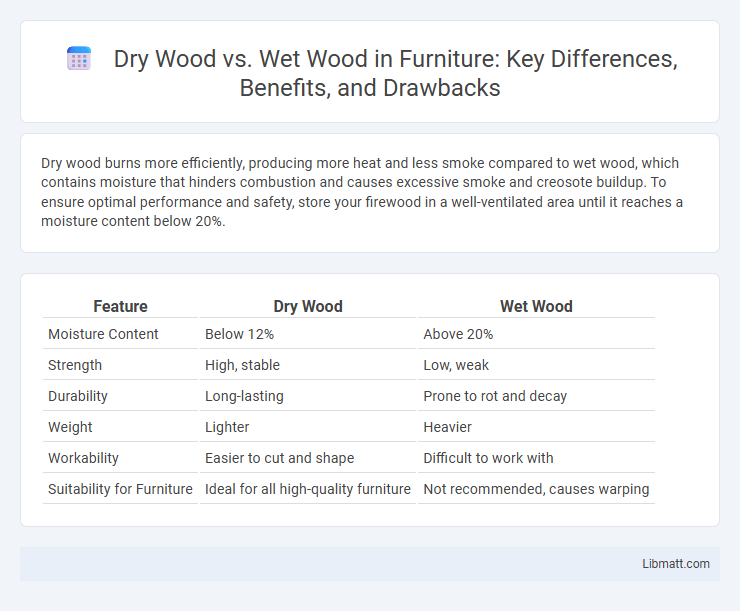Dry wood burns more efficiently, producing more heat and less smoke compared to wet wood, which contains moisture that hinders combustion and causes excessive smoke and creosote buildup. To ensure optimal performance and safety, store your firewood in a well-ventilated area until it reaches a moisture content below 20%.
Table of Comparison
| Feature | Dry Wood | Wet Wood |
|---|---|---|
| Moisture Content | Below 12% | Above 20% |
| Strength | High, stable | Low, weak |
| Durability | Long-lasting | Prone to rot and decay |
| Weight | Lighter | Heavier |
| Workability | Easier to cut and shape | Difficult to work with |
| Suitability for Furniture | Ideal for all high-quality furniture | Not recommended, causes warping |
Introduction to Dry Wood vs Wet Wood
Dry wood contains moisture levels below 20%, making it ideal for efficient burning and producing less smoke, while wet wood, with moisture content above 20%, burns poorly and generates more smoke and creosote buildup. Properly seasoned dry wood not only ensures higher heat output but also reduces environmental pollution compared to wet wood. When selecting firewood, understanding the difference can optimize Your fuel use and improve fireplace or stove performance significantly.
Moisture Content: Key Differences
Moisture content in dry wood typically ranges from 6% to 20%, while wet wood can contain 30% to over 100% moisture. This significant difference affects burning efficiency, with dry wood producing more heat and less smoke, making it ideal for heating and cooking. You should prioritize using dry wood to ensure better combustion and reduce creosote buildup in chimneys.
How to Identify Dry and Wet Wood
Dry wood typically has a lighter weight, cracks or splits on the ends, and a hollow sound when struck, indicating low moisture content below 20%. Wet wood appears darker, feels damp or sticky, and often has moss or a green tint, with moisture content above 30% detectable using a moisture meter. Identifying dry versus wet wood accurately is essential for efficient burning, as dry wood ignites faster and produces less smoke compared to wet, which creates more creosote and smoke, posing safety hazards.
Impact on Burning Efficiency
Dry wood burns with higher efficiency due to its low moisture content, producing more heat and less smoke compared to wet wood, which contains excess water that absorbs heat during evaporation. The presence of moisture in wet wood reduces combustion temperatures, leading to incomplete burning and increased creosote buildup in chimneys. For optimal burning efficiency and cleaner emissions, your firewood should have a moisture content below 20%.
Heat Output Comparison
Dry wood produces significantly more heat output than wet wood because it burns more efficiently, releasing maximum energy stored in the wood fibers. Wet wood contains moisture, which absorbs heat during combustion, resulting in lower temperatures and increased smoke production. Choosing dry wood for your fire ensures higher heat output and cleaner burning performance.
Smoke and Emissions: Environmental Effects
Dry wood produces significantly less smoke and harmful emissions compared to wet wood, resulting in cleaner combustion and reduced air pollution. Burning wet wood releases higher levels of particulate matter and volatile organic compounds (VOCs), contributing to smog formation and respiratory issues. Your choice of dry wood helps minimize environmental impact by promoting efficient burning and lowering greenhouse gas emissions.
Cost Implications for Consumers
Dry wood offers significant cost savings for consumers due to its higher efficiency and reduced burn time compared to wet wood, which burns inefficiently and produces more smoke and creosote buildup, leading to increased chimney cleaning and maintenance expenses. Wet wood requires more fuel to generate the same amount of heat, resulting in higher overall consumption and increased heating costs. Choosing dry wood improves your heating efficiency and reduces long-term expenses related to repairs and fuel consumption.
Effects on Fireplaces and Stoves
Dry wood burns more efficiently in fireplaces and stoves, producing higher heat output and less creosote buildup compared to wet wood. Wet wood generates excessive smoke, lowers combustion temperature, and increases the risk of chimney fires due to creosote accumulation. To maximize your fireplace or stove performance, always use properly seasoned dry wood.
Storage and Seasoning Methods
Dry wood requires proper storage in a well-ventilated, covered space to maintain low moisture content, ensuring efficient burning and reduced smoke. Seasoning methods typically involve stacking wood off the ground with gaps for air circulation, exposed to sunlight for 6 to 12 months to reach optimal dryness levels below 20% moisture. Wet wood, when improperly stored without adequate airflow or protection, retains high moisture, leading to inefficient combustion and increased creosote buildup in chimneys.
Choosing the Best Wood for Your Needs
Dry wood offers higher energy efficiency and cleaner burns compared to wet wood, which contains excess moisture that reduces heat output and produces more smoke. Selecting properly seasoned wood with moisture content below 20% ensures optimal combustion and minimized creosote buildup in your chimney. Your best choice depends on the intended use: dry hardwoods like oak or maple provide consistent heat for indoor fireplaces, while softer woods may suffice for outdoor fires.
dry wood vs wet wood Infographic

 libmatt.com
libmatt.com